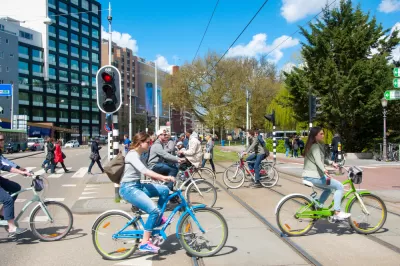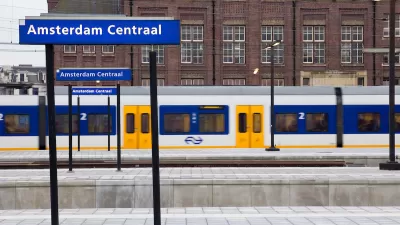European cities tend to be more walkable and transit-accessible—perhaps because they get the three Ds right (density, diversity, and design).

Last week, I went to Europe for the first time in over 20 years, and for the first time ever alone (as opposed to traveling with family or with a guided tour). Rather than going to the usual museums and tourist attractions, I explored Paris and Amsterdam the same way I would explore Detroit or Phoenix: as an urbanist, visiting as many neighborhoods as possible and comparing them to American cities.
Of course, both cities are far more walkable and transit-oriented than most American cities. In both, only about 30 percent of commuters use a car. Why?
Robert Cervero has written that three major elements affect travel patterns: density, diversity and design. Paris and Amsterdam are only moderately different from most American cities in the first two respects, but quite different in the last.
Compact cities tend to be more walkable and transit-friendly, because in a dense, compact city, more people can live within walking distance of shops and transit stops. Paris and Amsterdam are more dense than most of the United States—but not outstandingly so from my New York City perspective. Paris has about 55,000 people per square mile—more than New York City as a whole but less than Manhattan. Amsterdam is much less dense, with a little over 12,000 people per square mile- not many by New York standards, but still comparable to transit-friendly cities like Chicago and San Francisco. Even in Centrum (the most dense of Amsterdam's boroughs) there were only 28,000 people per square mile, only slightly more than the citywide average in New York.
In both cities, I stayed in transit-accessible suburbs rather than in the touristy, expensive core. But even in its suburbs, Paris seemed to have a high diversity of uses; it was very common to see shops on the ground floor of residential blocks, even in suburban Levallois where I stayed. This diversity makes it easier for people to walk to shops. Similarly, Centrum is mostly mixed-use. The post-World War II, suburb-y parts of Amsterdam, by contrast, do have areas dominated by residences. But in these neighborhoods, as in 1920s American streetcar suburbs, a commercial street was usually just a few blocks away.
The biggest difference between these cities and American cities, however, relates to design. Even in my Manhattan neighborhood, most street space is reserved for moving automobiles. By contrast, in Paris and Amsterdam there are fewer automobile lanes and more space for pedestrians (and, in Amsterdam, bicycles). In Levallois, I stayed on a two-lane street with one lane for parked cars and only one more lane for moving cars. Amsterdam had far more bike lanes, but also seemed to have a lot of one and two-lane streets. Narrow streets have obvious benefits for pedestrians and bicyclists: traffic is slower, and when you cross the streets you have fewer lanes to cross.
(Note: If you want to see photos of the neighborhoods I visited, the photos on my Facebook page are set as open to the public).

Alabama: Trump Terminates Settlements for Black Communities Harmed By Raw Sewage
Trump deemed the landmark civil rights agreement “illegal DEI and environmental justice policy.”

Study: Maui’s Plan to Convert Vacation Rentals to Long-Term Housing Could Cause Nearly $1 Billion Economic Loss
The plan would reduce visitor accommodation by 25% resulting in 1,900 jobs lost.

Why Should We Subsidize Public Transportation?
Many public transit agencies face financial stress due to rising costs, declining fare revenue, and declining subsidies. Transit advocates must provide a strong business case for increasing public transit funding.

Wind Energy on the Rise Despite Federal Policy Reversal
The Trump administration is revoking federal support for renewable energy, but demand for new projects continues unabated.

Passengers Flock to Caltrain After Electrification
The new electric trains are running faster and more reliably, leading to strong ridership growth on the Bay Area rail system.

Texas Churches Rally Behind ‘Yes in God’s Back Yard’ Legislation
Religious leaders want the state to reduce zoning regulations to streamline leasing church-owned land to housing developers.
Urban Design for Planners 1: Software Tools
This six-course series explores essential urban design concepts using open source software and equips planners with the tools they need to participate fully in the urban design process.
Planning for Universal Design
Learn the tools for implementing Universal Design in planning regulations.
Caltrans
Smith Gee Studio
Institute for Housing and Urban Development Studies (IHS)
City of Grandview
Harvard GSD Executive Education
Toledo-Lucas County Plan Commissions
Salt Lake City
NYU Wagner Graduate School of Public Service






























